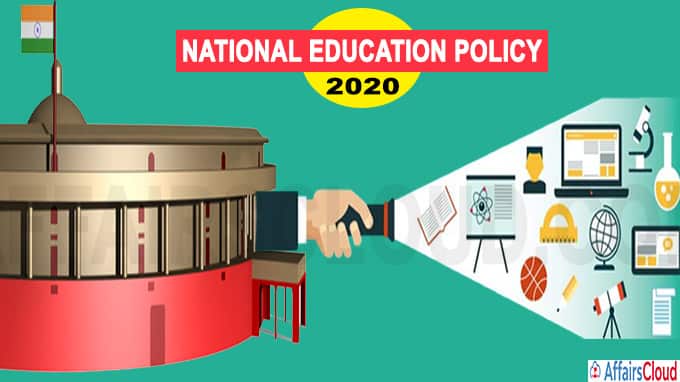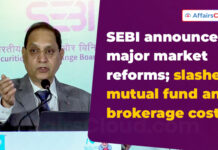 On July 29, 2020, Union Cabinet chaired by the Prime Minister Narendra Modi approved the first education policy of the 21st century i.e. National Education Policy (NEP) 2020 which has replaced 34 years old NPE, 1986. This was announced by Union Minister of Information and Broadcasting Prakash Keshav Javadekar. With this, the Ministry of Human Resource Development (MHRD) will officially be renamed the Ministry of Education (MoE).
On July 29, 2020, Union Cabinet chaired by the Prime Minister Narendra Modi approved the first education policy of the 21st century i.e. National Education Policy (NEP) 2020 which has replaced 34 years old NPE, 1986. This was announced by Union Minister of Information and Broadcasting Prakash Keshav Javadekar. With this, the Ministry of Human Resource Development (MHRD) will officially be renamed the Ministry of Education (MoE).
- The policy proposes to increase investment in education to reach 6% of total Gross Domestic Product(GDP). The current public (Government – Centre and States) expenditure on education in India has been around 4.43% of GDP as per the Analysis of Budgeted Expenditure 2017-18 and only around 10% of the total Government spending towards education as per the Economic Survey 2017-18.
- NEP 2020 emphasizes setting up of Gender Inclusion Fund, Special Education Zones for disadvantaged regions and groups.
- This new policy aligned to the Sustainable Development Goal (SDG)-4 of 2030 Agenda is aimed at Universalization of Education from pre-school to secondary level with 100 % Gross Enrolment Ratio (GER) in school education by 2030. Policy also aims to achieve 100% youth and adult literacy.
- Gross Enrolment Ratio (GER) in higher education is to be raised to 50% by 2035 from 26.8% in 2018 with the addition of 3.5 crore seats.
- Curriculum and pedagogy to be transformed by 2022 to promote skill based learning.Revision of NCF(National Curriculum Framework) for school education and NCF for teacher education 2009 by 2021.
The policy premised on the 5 pillars of Access, Equity, Quality, Affordability and Accountability has been created after the largest consultation and discussion process of its kind in the country. A total of 2.25 lakh suggestions received after the draft was placed in public domain for consultations.
School Education under NEP 2020:-
Early Childhood Care & Education (ECCE) to Secondary Education: –
Early Childhood Care & Education (ECCE) :-
ECCE consists of flexible, multi-faceted, multi-level, play-based, activity based, and discovery-based learning.
National Curricular and Pedagogical Framework for Early Childhood Care and Education (NCPFECCE) for children up to the age of 8 will be developed by National Council of Educational Research and Training (NCERT) in two parts, namely, a subframe work for 0-3-year olds, and a sub-framework for 3-8 years old.
The planning and implementation of ECCE will be carried out jointly by the Ministries of HRD, Women and Child Development (WCD), Health and Family Welfare (HFW), and Tribal Affairs.
Restructuring school curriculum and pedagogy:-
There is a major structural reform in the school system from the 10+2 model to 5+3+3+4 model in order to bring 2 crore out of school children back into the mainstream. It will consist of the following:
Foundational stage (5 years) – It will consist of 3 years of Anganwadi/pre-school aged covered 3 to 6 years old and 2 years in primary school of Grades 1-2 age covered 6 to 8 years old.Train the kids in multilevel, play/activity-based learning.
Preparatory Stage( 3 years)– An experiential learning across sciences, mathematics, arts, social sciences, and humanities will be introduced in Grades 3-5.
- Age covered: 8-11
Middle Stage(3 years)– It will have subject-oriented teaching and curricular style for Grades 6-8. The school system will integrate vocation education and internships from Class six onwards and activities involving coding will also be introduced at this stage. Students will also participate in a fun project/activity on The Languages of India, under the Ek Bharat Shrestha Bharat initiative.
- Age covered: 11-14
Secondary stage(4 years)- It will also consist of two parts i.e. Grade 9&10 + Grade 11&12 and will have greater depth curricular and student choice of subjects, and option to exit at grade 10 and re-enter at a later stage in grade 11. Several foreign languages will be offered at this level.
- Age covered: 14-18
Importance for Language skills
- Medium of instruction up to Grade 5, can extend till Grade 8 will be the mother tongue/regional language. This will be followed by both public and private schools.
- The three-language formula will continue to be implemented.
- In addition to Indian languages and English, foreign languages, such as Korean, Chinese, Japanese, Thai, French, German, Spanish, or Russian will also be offered at the secondary level, for students to learn about the cultures of the world and to increase their global knowledge.
Other Important Changes in School Education:
–Curriculum content will be reduced in each subject to make space for inquiry-based, discovery-based, discussion-based, and analysis-based learning.
–Mathematics and computational thinking to be given increased emphasis throughout school years.
–Students will get 360 degree holistic report card, which will not only include their marks, but also their skills.
—Bagless days will be encouraged in schools for enrichment activities involving arts, quizzes, sports, and vocational crafts.
–There will be Inclusion of specially-abled children in the schooling process.
—Indian Sign Language (ISL) will be standardized across India, and National and State curriculum materials developed for use by students with hearing impairment.
–NCERT and NCTE will develop guidelines for the education of gifted children. B.Ed. programmes may also allow a specialisation in the education of gifted children.
— Special emphasis will be given on Socially and Economically Disadvantaged Groups(SEDGs) which include gender, socio-cultural, and geographical identities and disabilities. This includes setting up of Gender Inclusion Fund and also Special Education Zones for disadvantaged regions and groups.
–Every state/district will be encouraged to establish “Bal Bhavans” as a special daytime boarding school, to participate in art-related, career-related, and play-related activities. Free school infrastructure can be used as Samajik Chetna Kendras.
Higher Education: The overall higher education sector will be integrated into one higher education system -including professional and vocational education.
- Multiple exit Options in UG: 4-year Undergraduate may also lead to a degree ‘with research’. A student can obtain a diploma after completing 1 year, or an advanced diploma in a field (including vocational and professional areas) after completing 2 years of study or obtain a Bachelor’s degree after a 3-year programme.
- An Academic Bank of Credit is to be established for digitally storing academic credits earned from different HEIs so that these can be transferred and counted towards the final degree earned.
- Multidisciplinary Education and Research Universities (MERUs), at par with Indian Institutes of Technology (IITs), Indian Institutes of Management (IIMs), to be set up as models of best multidisciplinary education of global standards in the country.
- Masters:- Students who have completed 4 years of bachelors’ programme with research could do one year master’s degree, then 5 year integrated bachelors’ / masters’ degree will also be available.Master’s degree or a 4-year Bachelor’s degree with Research would be eligible for pursuing Ph.D. The M. Phil programme would be discontinued.
- By 2025, the maximum number of colleges that can be affiliated by a University shall not exceed 300; this can be achieved by creating new universities. By 2035, all colleges currently affiliated to a university shall secure accreditation and become autonomous degree-granting colleges,through a concerted national effort.
- By 2040, all Higher Education Institutions (HEIs) shall become multidisciplinary institutions.
- The present terms of HEIs in the country as ‘deemed to be university’, ‘affiliating university’, ‘affiliating technical university’, ‘unitary university’ shall be replaced by ‘university’.
Policy Implementation by :-
Implementation of this Policy will be directed by the joint actions from various bodies including MoE, CABE, Union and State Governments, education-related Ministries, State Departments of Education, Boards, NTA(National Testing Agency), the regulatory bodies of school and higher education, NCERT, SCERT(State Council of Educational Research and Training), schools, and HEIs.
Advisory body of Indian Education System and Service:
The remodeled and rejuvenated Central Advisory Board of Education(CABE) shall also be responsible for developing, articulating, evaluating, and revising the vision of education in the country on a continuous basis, in close collaboration with MHRD and the corresponding apex bodies of States.
National Higher Education Regulatory Authority (NHERA) :- a common regulatory management for the entire higher education sector, eliminating duplication and disjunction of regulatory efforts.
National Council of Educational Research and Training (NCERT) :- adult education curriculum framework will be developed by a new and well-supported constituent body.
National Educational Alliance for Technology (NEAT):- It will be created to provide a platform for use of technology to enhance learning, assessment, planning, administration, and so on, both for school and higher education.
Authorities/Curricular to be set up under NEP 2020:
NCPFECCE: National Council of Educational Research and Training (NCERT) will develop a National Curricular and Pedagogical Framework for Early Childhood Care and Education (NCPFECCE) for children up to the age of 8.
NCFSE: A comprehensive National Curricular Framework for School Education (NCFSE 2020-21) will be developed by the NCERT.
PARAKH: As a part of Assessment reforms in schools, a National Assessment Centre, PARAKH (Performance Assessment, Review, and Analysis of Knowledge for Holistic Development) will be set up as a standard-setting body. Teachers are to be prepared for assessment reforms by 2023.
NRF: The National Research Foundation (NRF) will be created as an apex body for fostering a strong research culture and building research capacity across higher education.
NCFTE: A comprehensive National Curriculum Framework for Teacher Education (NCFTE 2021), will be formulated by the National Council for Teacher Education (NCTE) in consultation with NCERT. By 2030, the minimum degree qualification for teaching will be a 4-year integrated B.Ed. degree
NPST: For recruitment of teachers, a common National Professional Standards for Teachers (NPST) will be developed by the National Council for Teacher Education by 2022, in consultation with NCERT, SCERTs (State Council of Educational Research and Training), teachers and expert organizations.
SSSA: For standard-setting and accreditation for school Education, states/UTs will set up an independent State School Standards Authority (SSSA). The SCERT will develop a School Quality Assessment and Accreditation Framework (SQAAF) through consultations with all stakeholders.
NETF: An autonomous body, the National Educational Technology Forum (NETF), will be created to provide a platform for the free exchange of ideas on the use of technology.
NCIVE : Vocational education will be integrated into all school and higher education institutions in a phased manner over the next decade.MHRD will constitute a National Committee for the Integration of Vocational Education (NCIVE), consisting of experts in vocational education and representatives from across Ministries.
IITI: NEP recommends setting up an Indian Institute of Translation and Interpretation (IITI), National Institute (or Institutes) for Pali, Persian and Prakrit, and strengthening of Sanskrit and all language departments in Higher Education Institutes (HEIs).
CPD : Continuous Professional Development (CPD) Each teacher will be expected to participate in at least 50 hours of CPD opportunities every year for their own professional development, driven by their own interests.
CMP : Career Management and Progression (CMP) is to recognize the teachers effort and hardwork, promotion, and salary structure will be developed, with multiple levels within each teacher stage under multiple parameters.
National Mission on Foundational Literacy and Numeracy: It will be launched by the Union Ministry of Human Resource Development (MHRD) for attaining universal foundational literacy and numeracy in all primary schools for all learners by grade 3 by 2025. States will prepare an implementation plan for this. A National Book Promotion Policy will also be formulated.
National Curriculum Framework NCF 2005 outlines many excellent strategies that are still relevant for accomplishing a more constructivist type of learning. This document will be revisited and updated by the end of 2020.
Regulatory System of Higher Education
HECI: Higher Education Commission of India (HECI) will be set up as a single overarching umbrella body for entire higher education, excluding medical and legal education. This means that multiple higher education regulators like the University Grants Commission (UGC), All Indian Council of Technical Education (AICTE) and National Council of Teacher Education (NCTE) will be merged into one. HECI will have four independent verticals :
- Higher Education Regulatory Council (NHERC) – First vertical of HECI, will function as the common, single point regulator for the higher education sector including teacher education and excluding medical and legal education.
- National Accreditation Council (NAC) – Second vertical of HECI will, therefore, be a ‘meta-accrediting body’.
- Higher Education Grants Council (HEGC)-Third vertical of HECI ,will carry out funding and financing of higher education.
- General Education Council (GEC) – Fourth Vertical of HECI, will frame expected learning outcomes for higher education programmes, also referred to as ‘graduate attributes’. A National Higher Education Qualification Framework (NHEQF) will be formulated by the GEC and it shall be in sync with the National Skills Qualifications Framework (NSQF).
Standard-setting and Accreditation for School Education: –
Department of School Education which is the apex state-level body in school education will be responsible for overall monitoring and policymaking for continual improvement of the system but it will not be involved with the provision and operation of schools or with the regulation of the system, in order to eliminate conflicts of interest.
b) The educational operations and service provision for the public schooling system of the whole state will be handled by the Directorate of School Education (DSE);
- All schools must follow certain basic standard parameters which will be created by the SCERT. All states/UTs will set up an independent, state-wide named State School Standards Authority (SSSA) which need to implement these frameworks for the State/UT.
- New private schools will have to obtain a License to Start a School (LSS) from SSSA, academic matters, including academic standards and curricula in the State, will be led by the SCERT with consultation and collaboration with the NCERT.
Online and Digital Education:-
Teaching-learning e-content will continue to be developed by all States in all regional languages, as well as by the NCERT, CIET, CBSE, NIOS, and other bodies/institutions, and will be uploaded onto the DIKSHA platform.
Online teaching platform and tools: E-learning platforms such as SWAYAM, DIKSHA, will be extended to provide teachers with a structured, user-friendly for monitoring progress of learners.
Virtual Labs: Existing e-learning platforms such as DIKSHA, SWAYAM and SWAYAMPRABHA will also be influenced such labs for the students able to get equal access to quality practical and hands-on experiment-based learning experiences.
Pilot studies for online education: Appropriate agencies, such as the NETF, CIET, NIOS, IGNOU, IITs, NITs, etc. will be identified to conduct a series of pilot studies, in parallel, to evaluate the benefits of integrating education with online education and also to study related areas, such as, student device addiction, most preferred formats of e-content, etc.
Quick Recall of NPE:-
i.National Policy on Education (NPE) is framed by the Government of India to promote education. The policy covers elementary education to colleges in both rural and urban India. The first NPE was promulgated in 1968 by the government of Prime Minister Indira Gandhi, the second by Prime Minister Rajiv Gandhi in 1986.
The 1986 National Policy on Education was modified in 1992 by the P.V. Narasimha Rao government. In 2005, Former Prime Minister Manmohan Singh adopted a new policy based on the “Common Minimum Programme” of his United Progressive Alliance (UPA) government.The third National Educational policy was framed by Prime Minister Narendra Modi in 2020.
ii.Background of NEP, 2020:
–In May 2016, Committee for Evolution of the New Education Policy under the Chairmanship of Late Thirumanilaiyur Sitapati Ramana (TSR) Subramanian, Former Cabinet Secretary, submitted its report. Based on this, the HRD Ministry prepared ‘Some Inputs for the Draft National Education Policy, 2016’.
–In June 2017, Committee for the Draft National Education Policy was constituted under the Chairmanship of eminent scientist Dr. Krishnaswamy Kasturirangan, which submitted the Draft National Education Policy, 2019 to the HRD Ministry on 31st May, 2019.
iii.Evolution of Education Policy:
University Education Commission (1948-49)
Secondary Education Commission (1952-53)
Education Commission (1964-66) under Dr. D. S. Kothari
National Policy on Education, 1968
42nd Constitutional Amendment, 1976- Education in Concurrent list
National Policy on Education (NPE), 1986
NPE 1986 Modified in 1992 (Programme of Action, 1992)
T.S.R. Subramaniam Committee Report (May 27, 2016)
Dr. Krishnaswamy Kasturirangan Committee Report (May 31, 2019)
Recent Related News:
On May 14, 2020 The Ministry of Human Resource Development has developed an e-Governance platform, SAMARTH Enterprises Resource Planning (ERP) under National Mission of Education in Information and Communication Technology Scheme(NMEICT) to provide quality education to students across all Universities & Higher Education Institutes(HEIs), which is the mission of Department of Higher Education.
About Ministry of Education (MoE):
Union Minister– Ramesh Pokhriyal ‘Nishank’ (Constituency: Hardwar, Uttarakhand)
Minister of State (MoS)– Sanjay Dhotre




